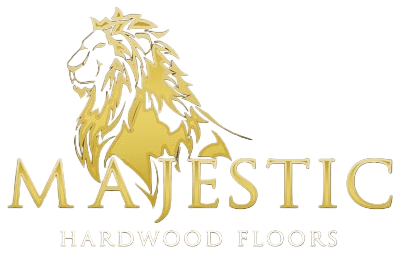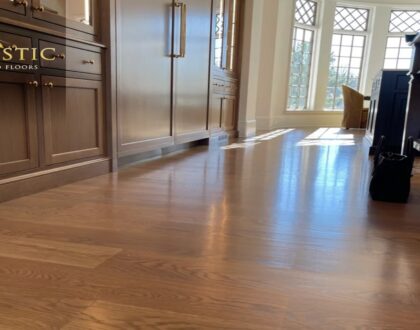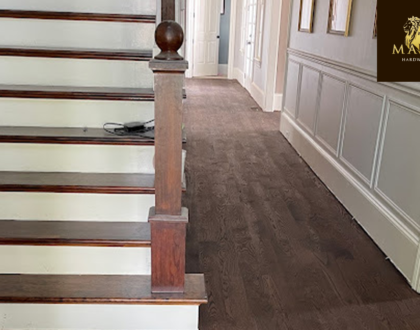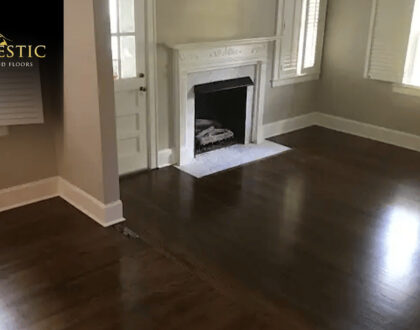Prefinished vs. Unfinished Hardwood Flooring: Choosing the Perfect Option for Your Home

When it comes to hardwood flooring, there are two main options to consider: prefinished and unfinished. Each type has its own set of advantages and disadvantages, and choosing the right one for your home is crucial. In this blog by Majestic Hardwood Floors, we will explore the differences between prefinished and unfinished hardwood flooring, considering factors such as installation, customization, cost, durability, aesthetics, environmental impact, maintenance, and market trends.
Advantages and Disadvantages of Prefinished Hardwood Flooring
Prefinished hardwood flooring refers to planks that are already finished in a factory before installation. Some advantages of prefinished hardwood flooring include:
Convenient and Time-Saving Installation: Prefinished planks are ready to be installed upon delivery, saving time and effort compared to the finishing process of unfinished hardwood flooring.
Consistent and Durable Factory Finish: Prefinished hardwood undergoes a controlled factory finish, ensuring consistent color, sheen, and durability throughout the surface of the planks.
Limited Downtime and Minimal Odor: Since prefinished hardwood is already finished, there is minimal downtime required for drying, and the odor associated with finishing is significantly reduced.
However, prefinished hardwood flooring also has some drawbacks:
Limited Customization Options: Prefinished planks offer a predetermined range of colors and finishes, limiting your ability to customize the appearance to match specific design preferences.
Visible Bevels and Edges: Prefinished planks often have beveled edges, which create slight grooves between each plank, affecting the overall smoothness and uniformity of the floor’s surface.
Potential for Slight Irregularities: During installation, slight gaps may occur between prefinished planks due to variations in plank sizes, which can detract from the seamless look of the floor.
Advantages and Disadvantages of Unfinished Hardwood Flooring
Unfinished hardwood flooring, on the other hand, is installed as raw wood, which is then sanded, stained, and finished on-site. Here are some advantages of unfinished hardwood flooring:
Customizable Finishes and Stains: With unfinished hardwood, you have the freedom to choose the exact stain and finish you desire, allowing for a personalized touch that matches your unique aesthetic preferences.
Seamless and Smooth Surface: Since unfinished planks are sanded and finished on-site, they provide a more consistent and seamless surface without visible bevels or grooves.
Ability to Match Existing Floors: Unfinished hardwood is an ideal choice for matching existing floors, as it can be customized to precisely mimic the color and finish of your current flooring.
Nevertheless, unfinished hardwood flooring does have its downsides:
Longer Installation Time and Messy Process: The installation of unfinished hardwood flooring requires additional time for sanding, staining, and finishing, resulting in a longer and messier installation process.
Strong Odor from Stains and Finishes: Unfinished hardwood emits a strong odor during the staining and finishing process, which may be unpleasant and require proper ventilation.
Higher Initial Costs: Unfinished hardwood flooring tends to have higher upfront costs compared to prefinished hardwood due to the additional labor and materials required for on-site finishing.
Cost Comparison
When considering the cost of hardwood flooring, it’s essential to look at both the initial costs and the long-term costs and maintenance requirements.
Initial Costs: Prefinished hardwood flooring generally has a lower initial cost compared to unfinished hardwood. This is because prefinished planks are factory-finished, reducing the need for on-site labor and materials.
Long-Term Costs and Maintenance: Both prefinished and unfinished hardwood flooring require regular maintenance to preserve their beauty and durability. Prefinished planks may have a slight advantage in terms of maintenance since the factory finish provides added protection against wear and tear. However, the long-term costs for both types are generally comparable.

Durability and Lifespan
When investing in hardwood flooring, durability and lifespan are crucial considerations. Here are some factors to keep in mind:
Wear Layer Thickness and Impact on Longevity: The wear layer thickness, which refers to the top surface of the hardwood plank, influences the longevity of the floor. Prefinished hardwood often has a thick factory-applied finish, offering enhanced resistance to scratches, dents, and stains.
Resistance to Scratches and Dents: While both prefinished and unfinished hardwood can withstand everyday use, prefinished planks generally have better scratch and dent resistance due to the durable factory finish.
Aesthetics and Design Options
The appearance of hardwood flooring plays a significant role in the overall design of your space. Consider the following factors:
Wide Range of Prefinished Colors and Styles: Prefinished hardwood flooring offers an extensive range of colors, finishes, and wood species to suit various design preferences. This variety simplifies the selection process and allows for easy coordination with existing decor.
Customization Potential with Unfinished Hardwood: Unfinished hardwood provides the opportunity for complete customization. By choosing on-site staining and finishing, you can achieve a unique color, sheen, and texture that aligns precisely with your vision.
Installation Process
Understanding the installation process for both prefinished and unfinished hardwood is essential when making a decision. Here’s an overview of each:
Prefinished Hardwood Installation Steps: Installing prefinished hardwood involves measuring and cutting the planks to fit the space, followed by securing them to the subfloor using nails, staples, or glue. The installation process is typically faster since the planks are prefinished.
Unfinished Hardwood Installation Steps: Installing unfinished hardwood includes several additional steps. After the planks are secured to the subfloor, the wood needs to be sanded, stained, and finished on-site. This process takes more time and requires skilled professionals.
Environmental Impact
Considering the environmental impact of your flooring choice is important. Let’s explore the sustainability aspects of both prefinished and unfinished hardwood flooring:
Sustainability of Prefinished Hardwood: Many prefinished hardwood manufacturers implement sustainable practices, such as sourcing wood from responsibly managed forests and using low-VOC finishes. Look for certifications like FSC (Forest Stewardship Council) to ensure the sustainability of the product.
Eco-Friendly Aspects of Unfinished Hardwood: Unfinished hardwood has the advantage of reducing waste during installation since the wood is cut and finished on-site, minimizing packaging materials. Additionally, some stains and finishes used on-site can be environmentally friendly if they meet specific criteria.
Maintenance and Repairs
Proper maintenance and timely repairs are essential for preserving the beauty and longevity of your hardwood floors. Consider the following tips:
Maintenance Tips for Prefinished Hardwood: Prefinished hardwood floors generally require routine sweeping or vacuuming to remove dirt and debris. Regular use of manufacturer-recommended cleaning products and avoiding excessive water exposure is key to maintaining the factory finish.
Maintenance Tips for Unfinished Hardwood: Unfinished hardwood floors need regular cleaning, dusting, and occasional refinishing to maintain their appearance. Proper care involves using appropriate cleaning products, avoiding excess moisture, and promptly addressing any spills or stains.
Repairing Scratches and Damage: Both prefinished and unfinished hardwood can be repaired if scratches or damage occur. Minor scratches can often be fixed with touch-up kits, while more significant damage may require sanding and refinishing by professionals.
Market Trends and Popular Choices
Understanding current market trends and popular choices can provide insights into the preferences of homeowners. Consider the following:
Current Trends in Hardwood Flooring: In recent years, wider planks, lighter shades, and natural textures have gained popularity in hardwood flooring. Additionally, homeowners are increasingly opting for environmentally friendly and sustainable options.
Most Popular Choice among Homeowners: The most popular choice between prefinished and unfinished hardwood varies depending on factors such as personal preferences, budget, timeline, and desired aesthetics. Ultimately, the decision should align with your specific needs and priorities.
Wrapping Up
Choosing between prefinished and unfinished hardwood flooring involves carefully considering the pros and cons of each option. Choosing between prefinished and unfinished hardwood flooring requires careful consideration of various factors. Prefinished hardwood offers convenience, consistent factory finishes, and minimal downtime during installation. However, it comes with limited customization options and visible bevels. On the other hand, unfinished hardwood provides the flexibility to customize finishes and stains, seamless surfaces, and the ability to match existing floors. By carefully weighing the advantages and disadvantages of prefinished and unfinished hardwood flooring, you can choose the option that best suits your needs and creates a stunning, long-lasting foundation for your home.
For more informative guides on hardwood flooring, do check us out at Majestic Hardwood Floors!



